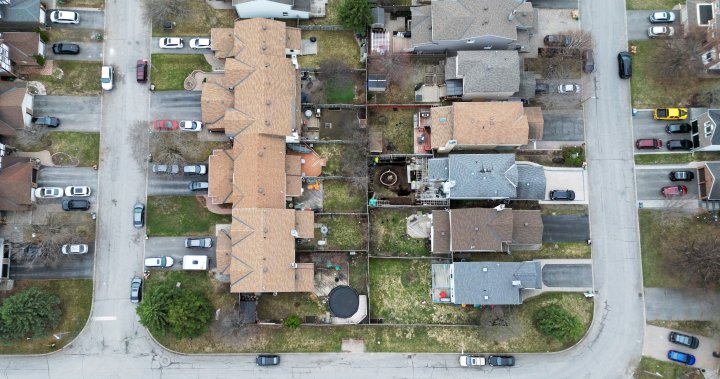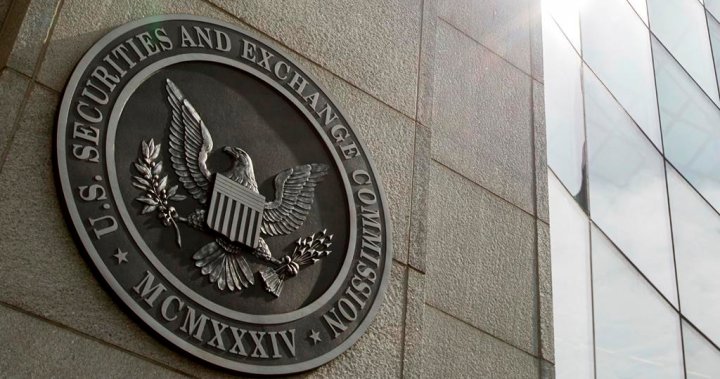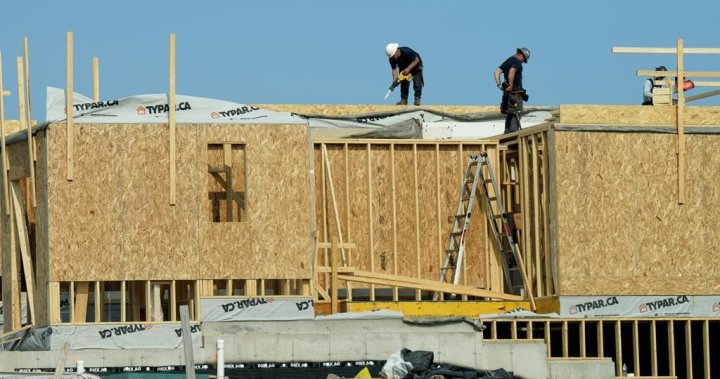The Canadian mortgage space is already seeing some rates on offer decline heading into the spring market, despite no clear indication yet from the Bank of Canada that interest rate cuts are imminent.
Experts who spoke to Global News say despite variable-rate mortgages remaining the more expensive option today, it’s a “good environment” to consider the product for homebuyers and refinancers who are comfortable with a bit more risk.
James Laird, co-CEO of Ratehub.ca, says it’s a better market to get a mortgage today than last fall when rates peaked.
Fixed mortgages on offer have declined to the point where some three- or five-year terms are carrying rates of less than five per cent. Some homebuyers can secure an insured five-year mortgage rate as low as 4.79 per cent, according to Ratehub’s aggregated list of rates on offer.
Fixed mortgage rates are tied to Canada’s bond market, which sees yields rise or fall depending on market expectations for interest rate cuts from the Bank of Canada.
“There’s been lots of optimism about rate cuts coming at some point this year,” Laird says.
Bank of Canada officials have been mum on when interest rates could start to decline following the most aggressive tightening cycle in the central bank’s history. Nonetheless, most economists are pencilling in rate cuts to start in late spring or early summer, depending on how inflation and other economic data unfold.
Tiff Macklem, the governor of the Bank of Canada, warned recently that even when rates do start to fall, they will not decrease at the pace they rose and are unlikely to return to their pandemic-era lows.
The recent decline in mortgage rates, combined with expectations that those rates will fall further, makes the choice between a fixed and variable option all the more difficult right now.
Fixed mortgage rates see a homeowner’s monthly payments and the associated interest rate hold steady through the length of the term.
A variable or adjustable rate mortgage is just that – variable. The contracted rate of interest rises and falls in line with decisions from the Bank of Canada, which could see a homeowner paying more or less depending on moves from the central bank.
Existing variable-rate holders know this reality well after the Bank of Canada raised its benchmark interest rate almost five percentage points over the past two years.
Variable mortgages were popular during the COVID-19 pandemic as they offered the lowest available rate at the time of purchase in most markets, though that interest rate rose dramatically amid the tightening cycle.
Some homeowners have an adjustable-rate loan with floating payments, which means their monthly mortgage bills immediately rise or fall in line with the Bank of Canada decisions. The other kind of variable-rate mortgage sees the amortization rate change but payments remain static, lengthening or shortening the amount of time over which the loan is paid back depending on how the interest rate changes.
Financial news and insights
delivered to your email every Saturday.
Financial news and insights
delivered to your email every Saturday.
There are limits to how long amortizations can stretch before a homeowner might have to take action, however, and these timelines reset to the contracted length at renewal.
For Canadians debating between a variable mortgage with floating payments or a fixed rate, there are a few important considerations to make, says Eitan Pinsky, a Vancouver-based mortgage expert.
Right now, variable-rate mortgages are the most expensive option. Pinsky says most variable rates on offer are around 6.1-6.5 per cent today.
He says that what Canadians in the housing market need to consider this spring is whether the Bank of Canada is likely to lower its policy rate by enough that the variable rate option ends up below their fixed counterparts over the course of the term.
According to his calculations, the Bank of Canada would probably need to drop around two percentage points over the next three years for a homeowner to save money going variable instead of fixed over that timeframe.
Someone with a variable-rate mortgage starting at 6.1 per cent would end up with an effective rate of 4.1 per cent by that point, while a fixed-rate holds steady around 4.99 per cent, in this example.
The math might work out, but Pinsky notes it’s contingent on the Bank of Canada bringing its rate down to 3.0 per cent by 2027. While that decrease isn’t outlandish, he says there are plenty of inflationary risks that could affect the central bank’s rate path.
“A lot can happen in three years,” he says.
Laird says it’s a “good environment” to consider a variable-rate mortgage as the odds of another interest rate hike from the Bank of Canada this cycle are slim at this juncture.
But it’s still a “riskier proposition” to take a variable mortgage over fixed, he says.
Another world event that drives up inflation like Russia’s invasion of Ukraine did two years ago could throw a wrench in the current forecasts for the Bank of Canada’s interest rate cycle, he says.
Because the risk of further rate hikes is never zero, Laird says Canadians banking on cuts to make the math work on their variable mortgage need to have some buffer in the budget should their monthly payments remain elevated through the term – or even rise higher.
“Variable (mortgages) do require a degree of financial flexibility and some comfort with a higher risk profile,” he says.
For this reason, Laird says some homeowners who believe interest rates will drop in the months ahead are still opting for five-year fixed-rate mortgages – the cheapest options on the market today – so they can save more upfront.
But Pinsky says most of the clients he’s dealing with are opting for a three-year fixed rate right now, which offers a slightly higher rate than the five-year option but with the promise of an earlier renewal when the cost of borrowing could be even lower.
One- and two-year fixed mortgages offer similar promise but are typically offered at much higher rates than the three-year option, which Pinsky says gives them less value right now than variable.
“The sweet spot really is the three-year fixed,” he says.
It’s not all about the monthly payment, however, and experts note there are areas where the variable rate comes out as a lower-risk option than the fixed model.
Homeowners who think there’s a good chance that they’ll sell their home or otherwise break their existing mortgage might want to consider the differences in penalties between fixed and variable mortgages.
Breaking a variable-rate mortgage will usually cost a homeowner the equivalent of three months’ interest payments on their loan.
The penalties for breaking a fixed-rate mortgage can be more costly depending on how long a homeowner has left on their mortgage term and the relative difference between their contract rate and the rates in today’s market.
If market rates fall as anticipated and a homeowner has to break their mortgage a year from now, the penalties can be bigger, as the lender will typically charge a fee based on the differential between the two rates.
When interest rates are lower than the contract rate when a homeowner breaks their mortgage, that’s when “penalties can get out of hand,” Laird says.
Pinsky adds that a homeowner can also expect to pay more if they break their fixed mortgage with a longer period of time left on their deal, which is a point in favour of taking shorter-term fixed rates over the popular five-year term.
For anyone who thinks they might break their mortgage at any point in the coming years, he says it’s a good idea to bring up the possibility with a broker or other mortgage professional so they can offer products that might limit the possible costs.
Homeowners with a variable rate also have the option of locking their interest rate into a fixed product at any point in their term without a fee, Pinsky adds, which can provide an out to those who are tired of the rate roller-coaster.
Even if a variable rate makes sense from a financial perspective, Pinsky says not every homeowner will want to “spend mental energy” checking the Bank of Canada’s rate decisions and worrying about how their payments or interest rate will change.
That’s a “specific decision per household” that factors in budget, risk and lifestyle changes that may come up over the course of a mortgage, he says.
“There’s not one answer for that.”




